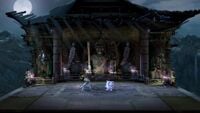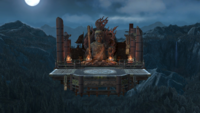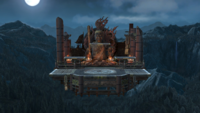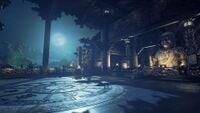Mishima Dojo: Difference between revisions
No edit summary |
mNo edit summary |
||
| Line 9: | Line 9: | ||
|hometo = {{SSBU|Kazuya}} | |hometo = {{SSBU|Kazuya}} | ||
|availability = [[Downloadable content|Downloadable]] | |availability = [[Downloadable content|Downloadable]] | ||
|cratetype = | |cratetype = Normal | ||
|maxplayers = [[8-Player Smash|8]] | |maxplayers = [[8-Player Smash|8]] | ||
|ultimatemusic = [[List of SSBU Music (Tekken series)|''Tekken'' series music]]<br>Main: ''{{SSBUMusicLink|Tekken|Kazuya Mishima, Devil Kazuya (Remix)}}''<br>Alternate: ''{{SSBUMusicLink|Tekken|Dojo (Japanese-Style Mix)}}'' | |ultimatemusic = [[List of SSBU Music (Tekken series)|''Tekken'' series music]]<br>Main: ''{{SSBUMusicLink|Tekken|Kazuya Mishima, Devil Kazuya (Remix)}}''<br>Alternate: ''{{SSBUMusicLink|Tekken|Dojo (Japanese-Style Mix)}}'' | ||
Revision as of 16:06, June 30, 2021
| Tekken 7 Mishima Dojo | |
|---|---|
File:SSBU-Tekken stage.png Mishima Dojo in Super Smash Bros. Ultimate. | |
| Universe | Tekken |
| Appears in | Ultimate |
| Availability | Downloadable |
| Crate type | Normal |
| Maximum players | 8 |
Mishima Dojo (三島道場, Mishima Dojo) is a downloadable stage in Super Smash Bros. Ultimate, based on the location of the same name from the Tekken series. It is the home stage of Kazuya, and is bundled with him as part of Challenger Pack 10.
Stage overview
The stage's layout is primarily flat, with walls blocking the left and right blast zones which can be broken through. After being broken, they will repair themselves after a certain amount of time has passed. Heihachi Mishima can be seen in front of the large Fudō Myōō statue in the center of the stage, sitting faced away from the action with his arms crossed; after a while, he stands up and proceeds to watch the battle, reacting to KOs.
There is a small inscription on the floor that roughly translates to Kazumi and Heihachi. This is a reference to Tekken lore, where both carved their names into the floor as a symbol of their love.
Ω form and Battlefield form
For the Ω form and Battlefield form, the walls and ceiling are permanently broken and the stage now floats far above the surface, and thus the stage's ledge walls do not extend below the blast line. The stage is also resized and reshaped to match Final Destination and Battlefield, respectively. The three soft platforms of the Battlefield form are wooden and resemble the wood flooring of the main platform.
Origin
The stage is designed around the Mishima Dojo as it appears in Tekken 7. While the walls and ceiling can not break in Mishima Dojo, they are able to in other Tekken stages. On the floor of the stage, it is possible to see the names of Heihachi and his deceased wife Kazumi Hachijo, which were engraved by them when they first fell in love. This detail is present in the original appearance of Mishima Dojo in Tekken 7, and originates from another similar stage in Tekken 2, Pagoda Temple.
Gallery
Kazuya with Mario.
Kazuya using Jump Side Kick against Captain Falcon on Mishima Dojo.
Trivia
- Mishima Dojo is the second stage which did not appear on Nintendo hardware before its debut in the Super Smash Bros. series, with the first being Midgar.
- However, Mishima Dojo is currently the only stage not to appear on Nintendo hardware outside of the Super Smash Bros. series in any form, as Midgar has appeared on the Nintendo Switch in Final Fantasy VII's rerelease since its inclusion as a stage.
|
| |
|---|---|
| Fighter | Kazuya (SSBU) |
| Stage | Mishima Dojo |
| Other | Heihachi Mishima |
| Spirits | Spirits |
| Music | Ultimate |











